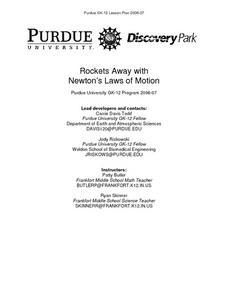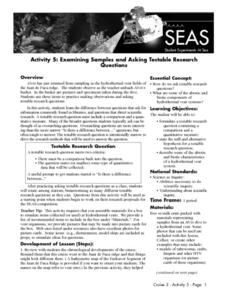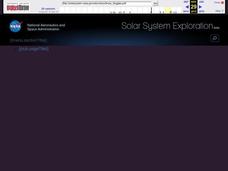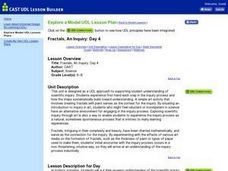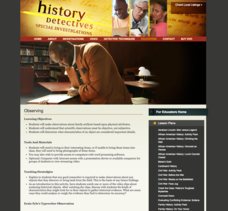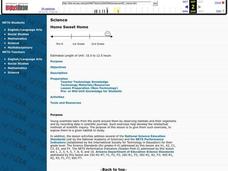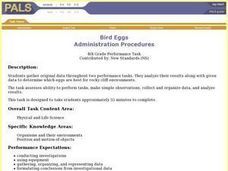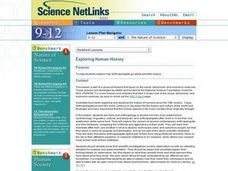Curated OER
Rockets Away with Newton's Laws of Motion
Eighth graders comprehend Newton's Laws of Motion and to use the scientific method in rocketry sub-unit. They work through the scientific method. Students illustrate how science and Newton's Laws can be used in everyday situations and...
Curated OER
Scientific Method
Students conduct an experiment and complete a chart demonstrating some of the basic properties and components of water via the scientific method. They encompass strategies such as questioning, making predictions, comparing/contrasting...
Curated OER
Measuring the Flagpole
Studets practice problem solving and comparison of quantities, ratios and prproportions. They develop a plan for determining the height of a flagpole complete with drawings and calculations. In addition, they complete a written...
Curated OER
Examining Samples and Asking Testable Research
Students formulate a testable research question containing a comparison and a
quantitative measure. They state the null and alternative hypothesis for a testable research question. In addition, they describe some of the abiotic
and...
Curated OER
Introducing the Use of Dichotomous Keys to Students
Students are introduced to the use of dichotomous keys as a simple means of beginning scientific observations in nature. They comprehend how to use a dichotomous key. Students distinguish characteristics of a group of organisms. They...
Curated OER
Alka-Seltzer Cannons
Fourth graders observe what is happening when an Alka-Seltzer tablet is placed in a clear cup of water. They observe the release of carbon dioxide gas. Pupils answer the question of how much as is released by observing the experiment...
Curated OER
Snow Goggles And Limiting Sunlight
Students build snow goggles similar to those used by the Inuit people. They create their version of the goggles to improve upon existing designs. Pupils compare the process used to invent snow goggles with that employed by the MESSENGER...
Curated OER
SAFETY KNOWLEDGE BASE CHANGES
Students research and formulate a hypothesis for research to correlate changing safety regulations in regards to personal and environmental safety polices for storage, handling and disposal of chemicals, risk involved in hazardous...
Curated OER
Where Do Plants Get Their Food?
Students think about the historical development of the scientific method. They design an experiment that replicates van Helmont's, using only specified materials. Pupils then improved upon van Helmont's procedure and also consider the...
Curated OER
Foodborne Illness Outbreak Investigation
Students demonstrate how epidemiological investigations of outbreaks are performed. They illustrate the principles of hypothesis formation and testing by epidemiologic study in the setting of an acute foodborne disease outbreak.
Curated OER
Fractals, An Inquiry: Day 4
Students put their growing understanding of the scientific inquiry process to work. They use paint to implement their plans to experiment with how changing one aspect of the fractal making process influences their appearance.
Curated OER
Diffusion
Students design and carry out an experiment according to the scientific method. The experiment must test the effects of time and concentration on the rate of diffusion of potassium permanganate into potato cubes. After performing the...
Curated OER
Scientific Method
Students examine the steps of the scientific method. They define related vocabulary terms, view a PowerPoint presentation, and apply and identify the steps of the scientific method for an online experiment scenario.
Curated OER
Let's Get Warm!
Students investigate various methods that animals use to warm up in cold weather. They also explore the science principals involved. They then identify a human parallel, discuss what we can learn from nature, and create multimedia...
Curated OER
The Science of Color
Students use the scientific method to explore how to make different colors with paint. They problem solve ways to darken and lighten colors without using black and white paint. Students hypothesize how to create new colors, and describe...
PBS
Predicting/Making a Hypothesis
Students analyze information from a variety of sources in order to create a hypothesis about the origin of an interesting family artifact.They create alternative hypotheses based upon available information to demonstrate that some...
PBS
Observation
Students study making scientific observations . They conduct a "field study" in their attic and make observations about their family artifacts based upon physical attributes. In addition, they determine what characteristics of an object...
Curated OER
Home Sweet Home
Students enjoy investigating and becoming aware of the habitats around them. They record their observations in scientific journals. Data collection can take the form of a simple drawing or taking digital photos or videos in the habitats...
Curated OER
An Activity to Introduce Critical Thinking
Students discover how easy it is to accept oulandish claims by witnessing a fellow student show that they have a form of ESP but is secretly working with the teacher. This demonstrations uses skepticism as a starting point for...
Curated OER
How Tall is that Tree?
Students apply their math skills to develop an accurate estimate of the height of a tall tree. Three different methods are outlined. All grade levels should be able to perform the shadow method and the proportional method.
Curated OER
Color Dots 2
Students develop simple observations. They observe bleeding of colored inks with water, to understand mixtures, and to make generalized inferences from their observations.
Curated OER
Bird Eggs
Students perform an experiment with different types of bird eggs to determine what factors make them strong and able to stay on a cliff without rolling off.
Curated OER
Exploring Human History
Students study the four main subdivisions of anthropology and how they overlap. They explore the careers of several contemporary anthropologists and their fieldwork, comparing the methods and applications of their work.
Curated OER
The Importance of Detailed Procedures in Science
Students examine the importance of clear communication in scientific exploration. In pairs, they write clear directions for an everyday activity for their partner to read and follow.


